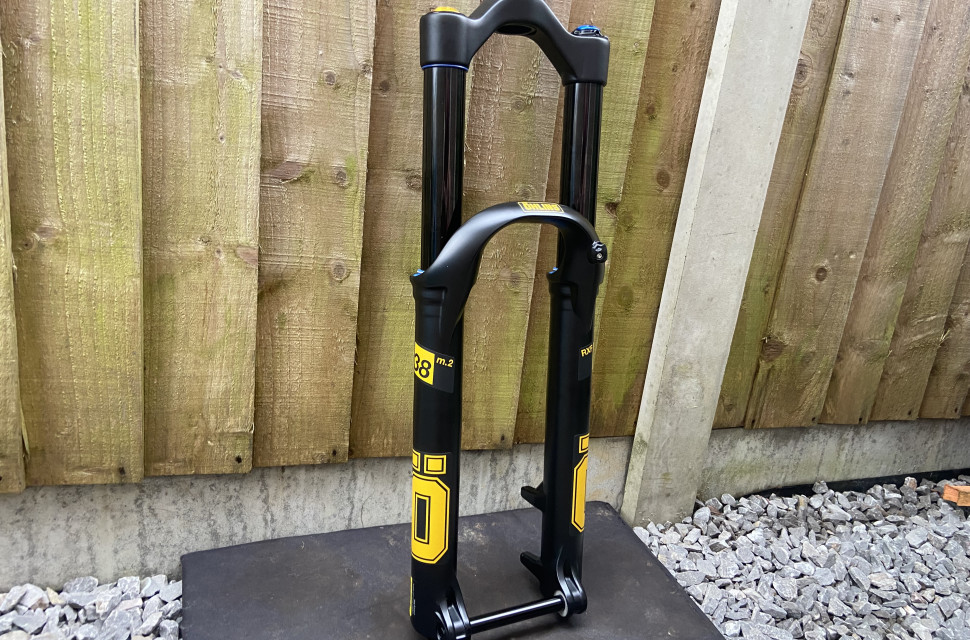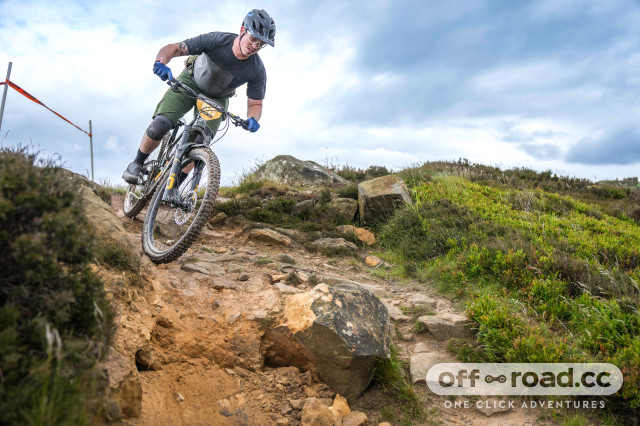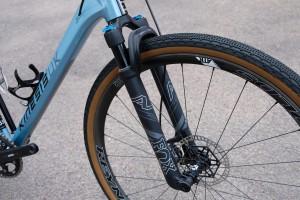The Ohlins RXF38 m.2 suspension fork is a noticeably improved model over the previous iteration. The mid-stroke support and chassis dynamics are impressive resulting in a fork that rewards hard-charging and never feels flustered. There are still some areas for Ohlins to work on, particularly the small-bump sensitivity, which can make the fork feel scatty and unpredictable on flat corners compared to other forks with the more usual air spring configuration. This fork requires time to get it running sweet but once sorted, it's up there with the best mountain bike forks.
- 9 tips to keep your suspension running sweeter for longer
- Manitou Mezzer Pro suspension fork review
- How to set up your mountain bike suspension
Ohlins RXF38 m.2 suspension fork - Technical details
The RXF38 m.2 is Ohlins' second iteration of its burly single-crown fork. Aimed at hardcore trail, enduro and e-MTB, the stout 38mm stanchions are claimed to be tuned to balance steering accuracy and control without making the fork feel harsh.
This fork comes with air or coil springs, 160, 170, and 180mm travel and the choice of 44mm or 51mm offsets. Along with a tapered steerer and e-bike rating, it should cater to everyone’s applications except those that require a 1.8in steerer option.
The lowers use a floating axle design that employs a pinch bolt to keep the axle in place once it has been installed. This design clamps the hub against the brake side leg without pushing the other leg against the hub – this ensures the legs remain exactly parallel to reduce friction from potentially misaligned lowers. The pinch bolt and axle both use a 5mm hex key.
The lowers also feature tyre clearance up to 29 x 2.6in and cater for a maximum brake rotor size of 220mm using a 200mm post mount. This burly enduro fork weighs 2,280g for the 180mm model with an uncut steerer.
Ohlins controls the damping with the twin-tube TTX18 cartridge. This design means the oil flows differently to a more common single-tube affair. Effectively the oil can flow both ways through the piston and via an additional chamber between the main piston and damper’s outer wall.
The 18 in TTX18 refers to the size of the main piston which is smaller than the original 22mm piston to provide a lighter range of damping adjustment.
Speaking of adjustment, externally there is low-speed rebound (16 clicks), low-speed compression (16 clicks), and high-speed compression. The high speed is a little unusual with four settings, the firmest of which acts as a lockout. Ohlins does offer alternative off-the-shelf valving tunes through its service partners if you need to dial it in further.
Ohlins has taken a slightly different approach to the way their air chamber works and is similar to EXT and Manitou. it's a cartridge affair and doesn’t seal against the inside of the stanchions which is good if you want to swap between air and coil springs. The three-chamber air cartridge features the usual positive and negative chambers along with a ramp-up chamber. This ramp-up chamber can be likened to using tokens in other forks but is adjusted via air pressure and a shock pump. The relation between the pressures in the main and ramp chambers impacts how early in the stroke and how aggressive the ramp-up of the air spring is.
This works by using an internal floating piston (IFP) at the top of the ramp-up chamber where with the fork fully extended the pressure holding the IFP up from the ramp-up chamber is greater than the pressure pushing it down from the air spring. As the fork is compressed through its travel the air spring pressure will increase and eventually overcome the pressure in the ramp chamber forcing the IFP to move down. The higher the pressure in the ramp chamber the further through the travel the IFP will not move and therefore keep the air spring volume low and increase the ramp up.
This approach has a couple of advantages over the usual tokens used. Progression can be easily adjusted trail side with the use of a shock pump as opposed to taking the fork apart to adjust tokens. The mid-stroke support is improved thanks to the positive chamber volume increasing as the fork moves deeper into its travel. The lack of mid-stroke support while finding it hard to use full travel is a common air spring problem that this design could address.
Ohlins RXF38 m.2 suspension fork - Setup
The mountain bike area of Ohlins’ website provides some baseline settings based on your bike, weight and preferred sag levels. This was super helpful to get rolling on an air spring I am unfamiliar with. Weighing in around 95kg, I used the recommended settings of 125psi in the main chamber and 20 psi in the ramp chamber.
On the damper side of things, the blue low-speed compression (LSC) dial has 16 clicks of adjustment and I started with it fully open. The high-speed compression (HSC) also started fully open to see how the fork reacted with the least amount of dampening. I like to run quite a fast fork so I fully opened the rebound dial at the bottom of the fork leg and after some car park bounces I dialled in a couple of clicks to get the rebound feeling balanced with the rear shock.
The dials and caps are of noticeably high quality, CNC-machined affairs which are tactile and easy to use. Each adjustment has a solid detent to it making each click obvious when turning.
As a side note, I noticed the damper and air spring positioning is opposite to the usual Fox and RockShox – that's not a bad thing, just an observation as I went to screw my shock pump into the damper side of the fork…
Ohlins RXF38 m.2 suspension fork - Performance
Initial impressions were a little underwhelming. it felt okay through the first part of the travel but was too linear and reached the end of the travel too easily. For the first ride, I tried to fix this with more compression damping but this made the fork feel more harsh and didn’t keep me up in the travel. To focus on keeping me up in the travel I added five psi to the main chamber and 25psi to the ramp-up chamber, this resulted in 25% sag. With 230psi in the ramp-up, the fork was holding up much better but still felt harsh in the initial part of the travel.
The next place to fettle was the negative chamber. Ohlins ship these forks with a small plastic spacer in the negative spring which can be removed to increase the negative volume. This involves removing the air spring from the fork and opening it up. Increasing the negative volume will help balance out the force between the positive and negative chambers removing the initial stiffness being felt. Back on the trail, there was a noticeable improvement in sensitivity with the negative spacer removed however this still fell short of the suppleness found on other forks.
Having the option to tune the ramp-up with a shock pump is a double-edged sword that allows unlimited fettling but requires persistence to get the performance you’re looking for. With the fork feeling harsh off the top my next move is to reduce the air spring pressure aiming for around 30% sag.
Even when running the spring a little softer, I found the front-end traction not as predictable as I’d like when weighting the front end in flat corners. The lack of suppleness early in the travel makes the front wheel feel skittish over small bumps.
On the descents, a real stand-out feature is the mid-stroke support which holds up the fork under braking and cornering. Once I fine-tuned the pressures in the fork the O-ring told me I was using the travel well. This mid-stroke support is a noticeable improvement over the usual air-sprung fork characteristics which lack the middle travel support and then ramps up aggressively making it hard to use the last part of the travel.
Although the small bump compliance was a bit lacking, this fork knows how to handle the rough stuff. The mid-travel support and tuneable ramp lend themselves well to hard hits and big compressions. Along with the burly chassis, this fork feels controlled and never overwhelmed.
On the damper side, the adjustments have a commendably useful range with either end of the adjustment being too much or too little and each click making a noticeable difference. With the air spring already giving plenty of support, I didn’t feel the need to use much compression dampening. The rebound was run fairly open but in a sensible place to balance the bike with the rear shock.
Ohlins RXF38 m.2 suspension fork - Verdict
Fox and RockShox are the mainstream trendsetters for suspension, so the respective 38 and ZEB are the direct competition for the RXF38 m.2. The Fox 38 is considered by many to be the benchmark and retailing at £1439 for the factory model (Grip X2) it's effectively the same price. The 38 has better sensitivity off the top and arguably tracks the ground better but I’ve found it has some mid-stroke harshness. The RockShox ZEB Ultimate retails for £1,120 and received an excellent review from our Liam. It boasts a very supple beginning stroke and loads of mid-stroke support but the air spring is very progressive which may result in struggling to reach the end of the stroke.
The mid-stroke support and responsive yet forgiving chassis are stand-out features that help this fork work well while charging over the rough stuff. The fork struggles with small-bump sensitivity, which can become fatiguing and gives a less confidence-inspiring feel, especially on flat corners. There is no doubt Ohlins has improved its RXF38 with the m.2 iteration – however, the small-bump sensitivity needs to be improved.















Add comment